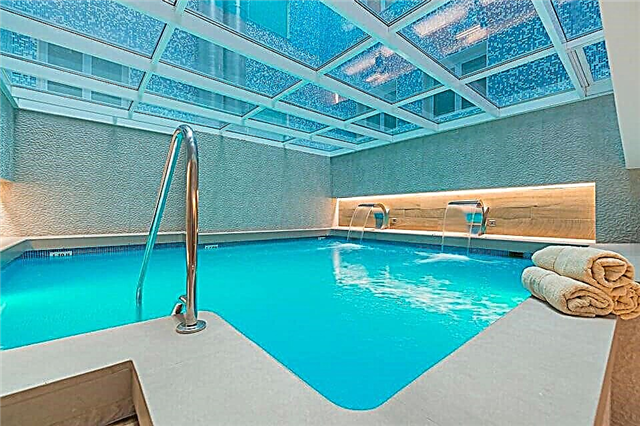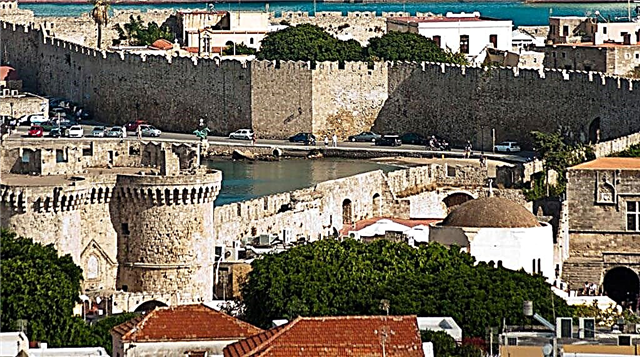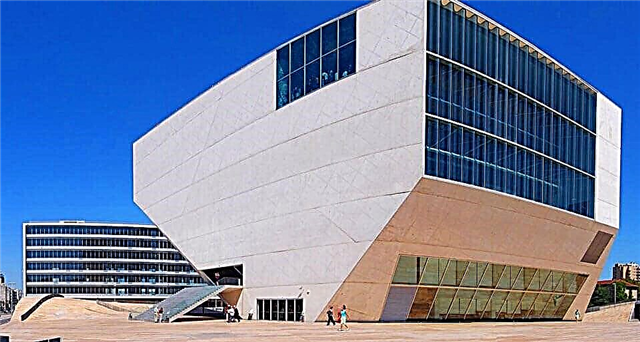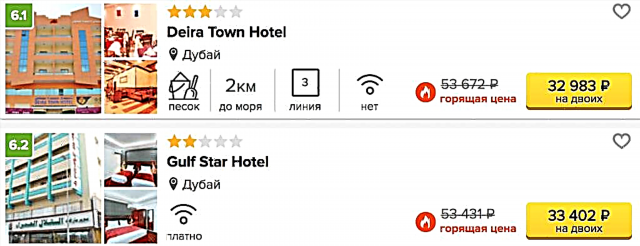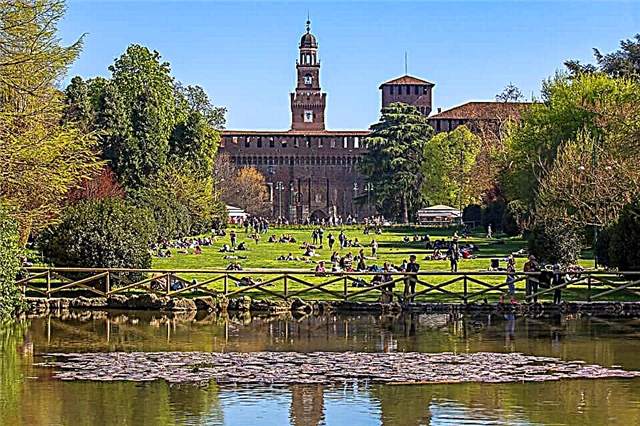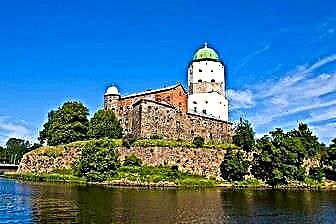In Vyborg, the feeling that you are somewhere in the vastness of Northern Europe does not leave. This is not surprising, because the city belonged to the Swedes for many centuries, and until the middle of the 20th century was part of Finland. The facades of stone buildings, fortresses, medieval towers, paving stones - all this is not at all typical for typical Russian architecture, only the familiar domes of Orthodox churches remind that this is not Scandinavia.
A large number of architectural monuments of the XIV-XVII centuries have been preserved in Vyborg. Unfortunately, some are in a depressing state, since during the Soviet and early Russian periods, the city authorities, apparently, had no time for sightseeing. The main attraction for travelers is the Vyborg Castle - the best site for historical reenactments and knightly tournaments.

The best hotels and hotels at affordable prices.
from 500 rubles / day
What to see and where to go in Vyborg?
The most interesting and beautiful places for walking. Photos and a short description.
Vyborg castle
Medieval Swedish fortress, founded under the regent Torgils Knutsson after a military campaign in the Karelian and Finnish lands. In the 18th century, it was taken by the troops of Peter I and since then has belonged to Russia, excluding the period from 1917 to 1940. The central building of the fortification is the St. Olaf's watchtower, named after the baptist of Scandinavia. This powerful tower with walls 4 meters thick has long been considered the highest keep in Northern Europe.

Alvar Aalto Library
The central library of the city, built in the 1930s by the architect A. Aalto. At that time, Vyborg still belonged to Finland. Architecturally, the building is a transition from neoclassicism to regional modernism. In 2014, the building was restored in accordance with the original drawings, after which it became a masterpiece of modern urban planning.

Esplanade Park
Central City Park, laid out in 1862 on the site of former defensive structures. Several dozen tree species grow on its territory. The alleys are decorated with statues "Elk", "Forest Boy", "Holy Family", a monument to Agricola. The figure "Elk" was created by the Finnish sculptor J. Mäntünen in 1928, copies of it are also available in Helsinki, Lahti and Turku.

Round Tower
The battle tower of the Vyborg fortress, built in the 16th - 17th centuries, is the only one that has survived to this day. After the capture of Vyborg by Russian troops, the structure lost its military significance and began to be used as an arsenal. In the 20th century, before the transfer of Vyborg to the Soviet Union, there were meeting rooms for city societies, a library and a restaurant. The Renaissance hall of the tower was painted with stories on historical themes. This mural was restored in the 1970s.

Town Hall Tower
A 15th century building that was part of the Vyborg defense system. After the loss of military significance in the 17th century, it served as the bell tower of the Dominican monastery, later - the belfry of the church of the Vyborg rural parish, now in ruins. In Soviet times, up to 1993, it collapsed and fell into decay. Since 1997, a church museum has been located on its territory.

Clock tower
The tallest tower in the old city, dominating the rest of the buildings. In the 15th century, it was erected as the bell tower of the cathedral, which was destroyed during the Soviet-Finnish war. The last restoration was carried out in the 1980s, but it was rather superficial, therefore, today the structure is in disrepair.

Vyborg market
A covered pavilion, designed by the Swedish architect K. H. af Segerstadt at the beginning of the 20th century. The architectural style of the building is austere and restrained Northern Art Nouveau. At that time, the Vyborg market was considered the largest in Scandinavia, therefore, the building for it was not small - with a central facade 20 meters wide and side walls more than 130 meters long. After restoration in the 1970s, many of the building's elements have lost their historical appearance.

Monument to Torgils Knutsson
The monument in honor of the founder of the Vyborg castle Torgils Knutsson is the work of the sculptor V. Wallgren. It was erected on the Old Town Hall Square in 1908 and became the first city monument. In 1948, the sculpture was dismantled, while severely damaging, but not completely destroyed. The monument was restored in 1993 on the 700th anniversary of the construction of the Vyborg Fortress.

Monument to Fyodor Apraksin
Monument of 2010, erected in honor of Admiral General F.M. Apraksin, who commanded the Russian fleet during the Northern War and the Persian campaign. The monument was designed by a group of sculptors. It is a bust of the commander, mounted on a granite pedestal in the form of a column. The Admiral purposefully peers into the distance, holding a telescope in his hand.

Monument to Peter I
The statue of the first Russian emperor is located on the territory of Petrovsky Park. It was installed in 1910 by decree of Nicholas II in honor of the 200th anniversary of the capture of the city by the Russian army. After the Finnish troops occupied the city in 1918, the monument was removed and was about to be scrapped, but instead placed in a museum storage. The monument finally returned to its place only in 1954.

Exhibition Center "Hermitage-Vyborg"
A branch of the State Hermitage, opened in 2010 on the site of the medieval fortress Panzerlax. Since the 1930s, it has housed a cultural center and a museum of fine arts, which were closed after the end of the Soviet-Finnish war. Today, collections from the main branch of the Hermitage in St. Petersburg are brought to the gallery, thematic lectures are held here and educational programs are developed.

War Museum of the Karelian Isthmus
Private exhibition dedicated to the Soviet-Finnish (Winter) War and its continuation in 1941–44. The exposition consists of archival documents, photographs, items found on the battlefield, samples of military uniforms and weapons that you can hold in your hands. The collection is located on the territory of the Central Barracks. The museum was created on the initiative of B.K. Irincheev, a military writer and businessman.

Historical and Cultural Center "Varyazhsky Dvor"
In the Vyborg district there is a tourist complex "Svargas" - a historical reconstruction of a prince's estate of the 11th century, created in 2005-2008 by a group of volunteers. Today this place is a site for all kinds of renovations. It is most suitable for the Viking Age and the Early Middle Ages, but attention is also paid to other stages from antiquity to modern times.

Transfiguration Cathedral
Orthodox church located on Cathedral Square. At the moment it is the city's cathedral. The building began to be erected in the 18th century by the decree of Catherine II. The architect N. A. Lvov worked on the first project. Later, the building changed its appearance several times as a result of reconstruction. The temple was not touched during the wars and during the period of Soviet power, so it is quite well preserved.

Cathedral of Saints Peter and Paul
The Lutheran Church of Vyborg, the only one that has survived to this day. It was erected in 1799, in 1839 an organ was brought here from Hanover, Germany, which was replaced 60 years later. At the end of the 19th century, restoration work was carried out under the leadership of J. Arenberg. Throughout its existence, the temple functioned. Now the parish is attended by about 300 people. Services are held in Russian and Finnish.

St. Elias Church
Orthodox Church on Ilinskaya Gora, built at the end of the 18th century by I. Brokman on donations from parishioners. During the Soviet-Finnish war, the building was damaged, later it was adapted for a club and a hostel. However, after 1945, the church was dismantled. The restoration took place in 1999 at the initiative of the believers. Today the temple is active, services are regularly held in it.

Cathedral of the dominican monastery
There was once a Dominican monastery in Vyborg, which was founded in the XIV century. Two centuries after the Reformation, the main cathedral of the monastery became Lutheran, the rest of the buildings were dismantled. The temple was destroyed during the Great Northern War, but later it was rebuilt and supported by the funds of the German community. In the XX century, during the fighting, the building was damaged, and in the late 1980s, as a result of a fire, it turned into ruins.

Viking Drakkars
Wooden boats are installed on the city embankment. They are replicas of Viking boats made in 1984 for the historical film Flowers Grow on the Stones. Until 2009, the ships used on the shooting were here, but they turned black with time and were replaced. The prototype of the ships became the real ships of the northern conquerors, and more specifically - the Gokstad ship located in one of the museums in Norway.

Church of Hyacinth
A small building in the Gothic style, the oldest part of which was built in the 16th century. In the 17th century, the Knight's House was located here. In 1799, by decree of Paul I, the building was transferred to the Order of Malta and adapted for a church. The temple existed until the end of the Soviet-Finnish war. In 1970, the building was restored and an art school was housed in it. An art gallery is currently operating here.

Burgher's estate
A stone building monument of the Swedish period, which is the home of a wealthy city dweller. The estate has changed owners many times - they have always been rich merchants and wealthy artisans. The house acquired its modern look after the 1979 restoration. Today, there is an exhibition hall on its territory, where guests are treated to Vyborg pretzel and a mug of ale.

House of the Merchant Guild of the Holy Spirit
Gothic town house, supposedly built in the 14th century. It is the oldest civilian building in the city. The building is one of four burgher houses - private buildings of the XIV-XVII centuries. Architectural forms of this type in Russia can be seen only in Vyborg. Initially, the estate was two-story - living rooms were located on the first floor, the second was used for negotiations.

Panzerlax Bastion
Medieval fortress of the 16th century, located on the coast of the Vyborg Bay. It was of strategic military importance until the beginning of the 19th century, then it began to interfere with the further expansion of the city, but it was still not demolished, like other defensive structures. At the beginning of the 20th century, the bastion was handed over to the civil authorities. In the 1930s, a building for a museum and an art school was built on its foundations, which was transformed in 2010 into a branch of the Hermitage.

Annenskie fortifications
Defensive structures of the 18th century on Tverdysh Island, which stretch along the Vyborg Bay. They were built to protect the city from the attack of the Swedish army from the north. The fortifications have survived to this day in good condition. Today, knightly tournaments, a dance festival, historical reenactments and other cultural events are held on their territory.

Battery mount
In the 19th century, Battery Mountain was part of the East Vyborg fortifications; today, the city Central Park is located on its territory. The need to build another line of defense arose due to the fact that after the demolition of the old fortress walls, Vyborg was not defended from the east, and the time was turbulent. Remains of stone walls, gates and tunnels have survived to this day.

Mon Repos Park
A landscape park in the northern part of Vyborg, created in the 18th – 19th centuries on the site of private property. This picturesque place harmoniously combines the beauty of nature and elements of spatial design. Among the trees and huge boulders, you can see pretty gazebos and benches, bridges and other architectural structures. The main building is a classicist manor.




